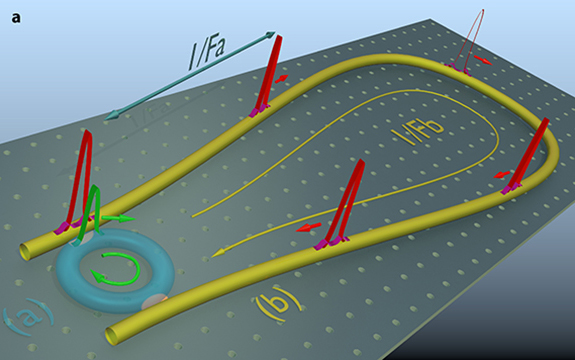New optical pulse seen in micro-combs may unlock practical applications

In Summary
- A new class of microcomb pulse may lead to pocket sized ultra-precise optical clocks able to replace GPS and other applications
An international team of researchers including Professor David Moss, Director of the Centre for Micro-Photonics at Swinburne, has reported the first observation of a new class of microcomb pulse that may ultimately lead to pocket sized ultra-precise optical clocks able to replace GPS and a host of other applications.
This new and distinct class of solitary pulses, called temporal laser cavity-solitons directly addresses many of the challenges current micro-cavity based frequency combs, or micro-combs face.
Micro-combs have enabled major breakthroughs in spectroscopy, communications, microwave photonics, frequency synthesis, optical ranging, quantum sources, metrology, and astro-combs.
They offer the full capability of optical frequency combs – the subject of the 2005 Nobel prize in physics to John Hall and Ted Hansch – but in a compact, integrated footprint.
To unlock their potential it is critical to be able to ‘lock’ the modes to each other, thus generating ultrashort optical pulses.
Several years ago, temporal cavity-soliton pulses were discovered that enabled this, and that have been instrumental in many of these breakthroughs. However, micro-combs still face numerous challenges preventing them from entering the real world.
Existing approaches require sophisticated instrumentation to initiate and control the pulses and, once initiated, they are difficult to control and very inefficient since they require a strong continuous background light to drive them.
By nesting a micro-comb in an optical fibre loop with an optical amplifier, the team has succeeded in harvesting the full capability of laser cavity-solitons, demonstrating highly efficient, broadband microcomb generation requiring much simpler methods to control and initiate.
They succeeded in producing bright solitons with average pump powers less than six per cent of current methods. Unlike existing approaches, these new solitons are ‘background-free’ – they do not require the large continuous background pump beam that current microcombs do and so they have a theoretical maximum efficiency of 96 per cent, versus six per cent for current approaches.
Furthermore, the team has demonstrated the ability to easily control critical parameters such as the pulse repetition rate without the use of active controls that in turn require highly sophisticated instrumentation.
“This is a real game-changer,” says Professor Moss.
“The elephant in the room with microcombs that nobody has been talking about is their huge inefficiency and the great difficulty in initiating and controlling. This new form of optical microcomb pulse opens a clear pathway for making microcombs simple, robust and efficient. Laser cavity-solitons represent a new and powerful mode of operation for microcombs, offering many advantages that will help these devices to move out of the laboratory towards real-world applications,” Professor Moss says.
Laser cavity-soliton microcombs has been published in Nature Photonics.

